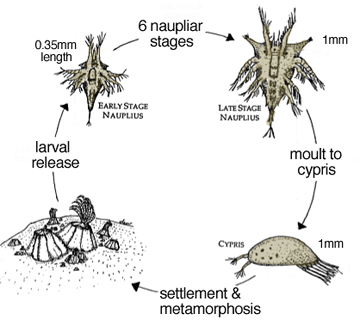Reproduction
Barnacles are sessile creatures. Thus, they cannot go and find
another member of their species farther away to reproduce with.
This means, in order for them to reproduce, they must mate with
a member closer to them, and have the characteristic of being
hermaphroditic. Being hermaphroditic means the barnacles have
both male and female sex organs (Ellis 2013). They can produce
both male sperm cells and female egg cells (Ellis 2013). Thus,
Chthamalus fragilis
can either reproduce with itself or fertilize an adjacent
neighbor. It may be convenient to reproduce with oneself;
however, self-fertilization does not create much genetic
diversity. When Chthamalus
fragilis needs to fertilize a neighbor, it can use a
retractable tube (UWT 2007). The tube can reach up to several
inches and contains sperm. This is how the sperm are delivered to a neighboring barnacle. Once the tube
is used, it is “thrown away”, and a new one is established for
the next reproductive season (UWT 2007).
hermaphroditic means the barnacles have
both male and female sex organs (Ellis 2013). They can produce
both male sperm cells and female egg cells (Ellis 2013). Thus,
Chthamalus fragilis
can either reproduce with itself or fertilize an adjacent
neighbor. It may be convenient to reproduce with oneself;
however, self-fertilization does not create much genetic
diversity. When Chthamalus
fragilis needs to fertilize a neighbor, it can use a
retractable tube (UWT 2007). The tube can reach up to several
inches and contains sperm. This is how the sperm are delivered to a neighboring barnacle. Once the tube
is used, it is “thrown away”, and a new one is established for
the next reproductive season (UWT 2007).
Once the egg is fertilized, it grows into a larvae. This
occurs for about a month inside of the adult barnacle. After a
month, the larvae is expelled out of the mouth of the adult as a
free-swimming larvae. This swimming and motility in the larval stage
of development allows C.
fragilis to settle new areas (WHOI n.d.). If the larval stage
did not have the characteristic of motility, then the species would
be confined to one area with high population density and intraspecie
competition would be high too. The first larval stage is nauplius.
At this time the young barnacles swim freely to eat and molt many
times to increase their size. They then move on to the second larval
stage which is the cypris stage. At this point, the larvae are
strictly set on finding a suitable
surface to settle on. Once the
larvae finds a proper place, with the help of ocean currents, the
larvae secretes a glue out of its
antennae and secretes calcium
carbonate to form a shell. It is now an adult barnacle. Its life
span ranges from eight to twenty years (Whoi n.d.).
Works Cited for Reproduction
Ellis, Michael. 2013. <URL:
http://baynature.org/articles/how-do-barnacles-make-baby-
barnacles/>.
Accessed 19 March 2014.
WHOI N.D. <URL:
http://www.whoi.edu/science/B/people/kamaral/Barnacles.html>.
Accessed 19 March 2014.
UWT 2007. <URL:
http://courses.washington.edu/mareco07/students/nina/barnacleshome.html>.
Accessed 19 March 2014.
Home | Classification | Habitat | Adaptation | Nutrition | Interactions | Facts | References
| Contact Us |
